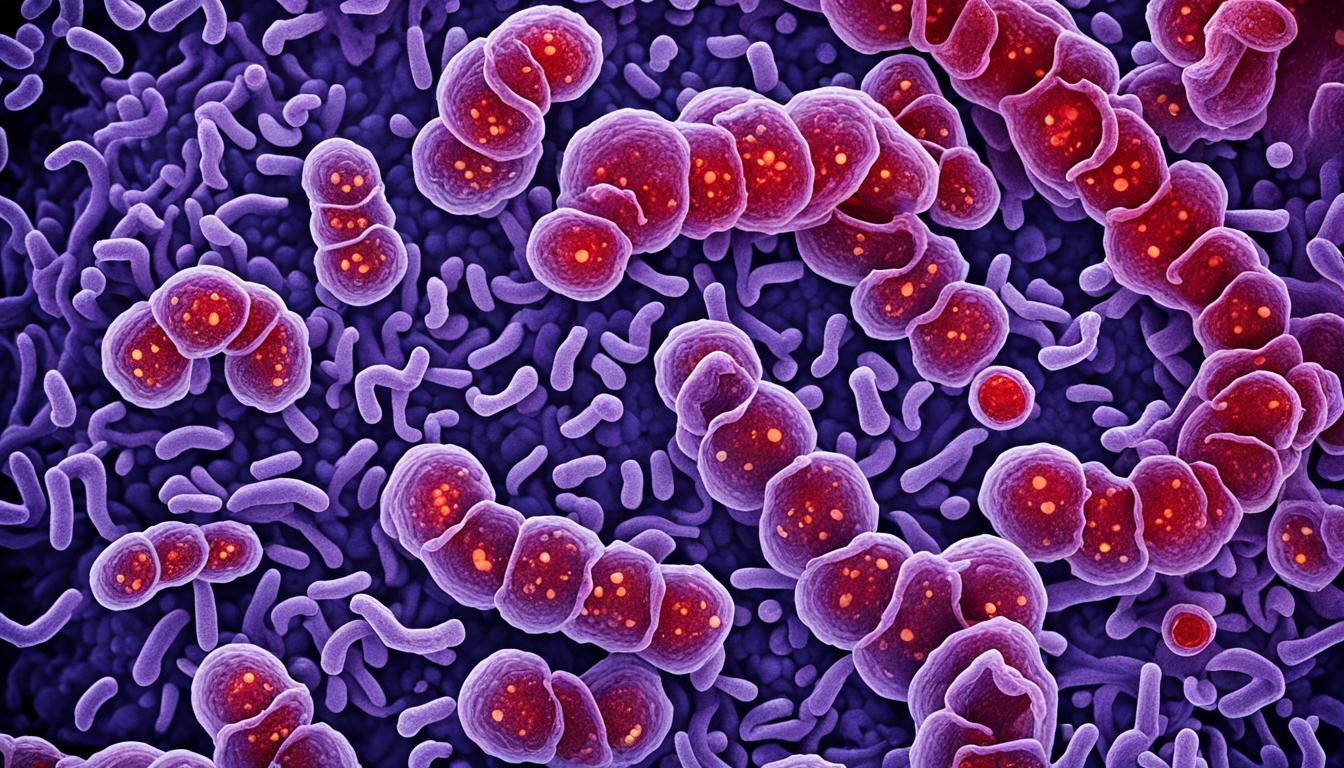Clostridioides difficile infection (CDI) is a bacterial illness. It often leads to bad diarrhea, especially after taking antibiotics. The cause is the bacterium Clostridioides difficile (formerly Clostridium difficile).
CDI can cause issues like stomach pain, needing to go to the bathroom a lot, and fever. This happens because antibiotics can mess up the good bacteria in our guts. Without this good bacteria, C. difficile can grow out of control.
Doctors use stool tests to find C. difficile toxins and confirm CDI. They treat it with medicines like metronidazole or vancomycin. Sometimes, they even use other methods like putting healthy gut bacteria back through a transplant. Stem cell therapy is also a promising way to treat CDI.
Key Takeaways:
- Clostridioides difficile infection (CDI) is caused by the bacterium Clostridioides difficile.
- CDI commonly causes infectious diarrhea, especially after the use of antibiotics.
- CDI can be diagnosed through stool tests to detect C. difficile toxins.
- Treatment options for CDI include antibiotics, fecal microbiota transplant, and stem cell therapy.
- Preventing CDI involves responsible antibiotic usage and proper infection control measures.
Risk factors and epidemiology of Clostridium difficile infection
To see how common and harmful Clostridium difficile infection (CDI) is, we must look at its risk factors and spread. CDI comes from the bacteria Clostridium difficile and is a big problem in healthcare. Some big reasons CDI happens are:
- Being older can make you more likely to get CDI. This is because being old means your immune system might be weaker. There’s also a chance you take more antibiotics which can cause CDI.
- Taking antibiotics recently also raises your risk. These drugs mess with the good bacteria in your gut. This lets C. difficile grow more easily, leading to infection.
- Staying in the hospital for a long time is a big risk. CDI happens a lot in places like hospitals. The more time you spend there, the more you could be exposed to C. difficile.
- Having health issues like inflammatory bowel disease can also make you more likely to get CDI. Even if your immune system is compromised, the risk goes up.
CDI can happen in hospitals or out in the world, but it’s seen more in medical settings. The heavy use of antibiotics and the number of fragile patients there means CDI spreads easier. However, catching CDI outside these places isn’t common, but it still happens sometimes.
Epidemiology data:
| Epidemiological Factors | Findings |
|---|---|
| Prevalence in healthcare settings | High |
| Prevalence in the community | Lower, but still present |
| Hematopoietic stem cell transplantation (HSCT) recipients | Incidence can be as high as 20-30% |
People who have had hematopoietic stem cell transplants are at a very high risk for CDI. They take powerful medicines to suppress their immune system. This, added to their long stays in hospitals and use of antibiotics, makes CDI more likely. Research has found that CDI affects 20 to 30% of these people. It can lead to serious problems and harm their recovery from the transplant. It’s important to spot and treat these risk factors to lessen the chance of CDI.
Image
It’s key for healthcare workers to know about CDI risks and how it spreads. By figuring out who’s most at risk and taking steps to lower these risks, we can cut down on CDI cases. This could make a big difference in fighting CDI.
Treatment options for Clostridioides difficile infection
When dealing with a Clostridioides difficile infection (CDI), we have a few treatments. These include antibiotics, fecal microbiota transplant (FMT), and stem cell therapy.
For antibiotics, metronidazole and vancomycin are common choices. Guidelines now prefer vancomycin over metronidazole for severe cases. These antibiotics fight the C. difficile bacteria causing the infection.
Fidaxomicin is also an option and can be effective. It stops the growth of C. difficile bacteria, lowering the chance of the infection coming back.
If CDI comes back after treatment, there are more options to consider. These include fidaxomicin, special vancomycin schedules, and FMT.
FMT involves transferring stool from a healthy donor to the patient’s gut. This helps the patient’s gut bacteria return to a healthy balance and works well for recurrent CDI.
Stem cell therapy is new and uses stem cells to repair the gut lining and help balance gut bacteria. This treatment is still being studied, but it might offer a long-lasting solution for CDI.
Comparison of Treatment Options for CDI:
| Treatment Option | Mode of Action | Efficacy | Potential Side Effects |
|---|---|---|---|
| Metronidazole | Kills C. difficile bacteria | Moderate | Nausea, metallic taste |
| Vancomycin | Kills C. difficile bacteria | High | Nausea, diarrhea |
| Fidaxomicin | Inhibits C. difficile growth | High | Nausea, abdominal pain |
| Fecal Microbiota Transplant (FMT) | Restores healthy gut microbiota | High | None reported |
| Stem Cell Therapy | Repairs damaged tissue, restores microbiota | Potential | Unknown |
Table: A comparison of treatment options for Clostridioides difficile infection.
Choosing the right treatment for CDI depends on its severity, how often it comes back, and the patient’s needs. Talking to a doctor is the best way to find the right treatment for you.
Conclusion
Clostridioides difficile infection (CDI) is common and serious, needing fast treatment. This is very important for people like HSCT recipients. Good treatment can lead to better results and fewer problems.
Antibiotics are often used to treat CDI. But, there are new methods, like stem cell therapy and FMT, that seem promising. These new ways might change how we fight CDI.
Yet, we need more studies and tests on stem cell therapy and FMT for CDI and HSCT patients. If successful, these new treatments could change how we deal with CDI. They might bring better health for those affected.

